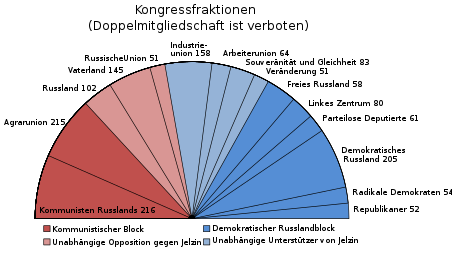Russian constitutional crisis 1993
| date | September 21, 1993 to October 4, 1993 |
|---|---|
| place | Moscow , Russia |
| output | * Yeltsin's victory * Alexander Ruzkoi and Ruslan Khasbulatow arrested * 120 dead |
| Parties to the conflict | |
|---|---|
|
|
|
| Commander | |
|
|
|
The Russian constitutional crisis in 1993 began on September 21, when Russian President Boris Yeltsin dissolved the Legislative Congress of People's Deputies and the Supreme Soviet of Russia by decree .
background
After the August coup in Moscow and the collapse of the Soviet Union in 1991, tensions arose repeatedly between the Congress of People's Deputies of Russia, which was still elected during the Soviet era, and the Russian President Yeltsin.
course
In the power struggle between the People's Deputies Congress, which is regarded as hostile to reform, under the chairman of the Supreme Soviet of Russia (e.g. President of Parliament) Ruslan Khasbulatow , and the reformer Yeltsin, the latter pushed through a referendum on the government's economic policy in the People's Deputies Congress , which he won on April 25, 1993 with 58.1 Percent of the vote won. As a result, a constitutional conference of all social forces convened by Yeltsin presented a new draft constitution in July.
However, the parliament rejected the draft constitution, whereupon Yeltsin unconstitutionally dissolved parliament by decree and announced new elections and a referendum on the constitution drafted by the constitutional conference for December 12th. The People's Deputies Congress rejected Yeltsin's decree and decided to impeach Yeltsin from the presidency. His estranged Vice President Alexander Ruzkoi was sworn in as incumbent president according to the existing constitution. Ruzkoi, in turn, appointed his own defense minister as part of a counter-government. On September 28, public protests against Yeltsin's government began in the streets of Moscow, with the first bloodshed. The army remained under Yeltsin's control, which ultimately determined the outcome of the crisis. The people's deputies barricaded themselves in the White House , the parliament building. Over the following week, the anti-Yeltsin protests grew until they peaked on October 2nd. Russia was on the brink of civil war . However, instead of trying to establish his counter-defense minister in the Ministry of Defense , Ruzkoi called for the Ostankino television studio to be occupied. The armed assault of his supporters on the television studio failed after heavy night fighting on October 3rd. From then on, the higher levels of command in the security services and the military supported Yeltsin. Army troops besieged the parliament building, shot at it with tank shells and almost destroyed it. Most of the deputies now fled. On October 5th, the armed resistance against Yeltsin collapsed. The ten-day conflict has been the street fight with the most dead in Moscow since the October Revolution of 1917. According to the government, 187 people died and 437 were injured in the crisis (almost all supporters of Congress). Yeltsin was never prosecuted for violating the constitution or using weapons against the elected parliament.
In December, the Russian people approved Russia's new constitution by referendum . In the new elections, the Congress of People's Deputies was replaced by the newly created bicameral parliament with a Federation Council and Duma . The office of Vice President was abolished. Yeltsin's opponents again won a majority in the Russian parliamentary elections in 1993 , also because of the disagreement in the so-called reform camp . As early as February 26, 1994, at the request of the nationalist LDPR under Vladimir Zhirinovsky , together with the newly organized communists of the KPRF and against the protests of Yeltsin, an amnesty for the putschists of the August putsch in 1991 and the rebels of 1993 was decided.
- Development of the composition of the Congress of Russian People's Deputies between April 1991 and March 1993
International level
Several heads of government and state from the CIS region and Western Europe supported Yeltsin, including the German Chancellor Helmut Kohl .
Volunteers came from Transnistria to defend Parliament.
Web links
- Friedemann Kohler: When grenade fires echoed through Moscow , stern.de, December 4, 2003.
- Bo - Fax: Security guarantees for Ruzkoj and Khasbulatow - application of international humanitarian law? ( Memento of August 24, 2005 in the Internet Archive ) (PDF; 9 kB)
Individual evidence
- ↑ Markus Wehner : Ruslan Chasbulatow: The hopes disappointed , in: Frankfurter Allgemeine Zeitung, August 19, 2003. Available here.
- ↑ https://www.antifainfoblatt.de/artikel/nationale-revolution in-russland ( page no longer available , search in web archives ) Info: The link was automatically marked defective. Please check the link according to the instructions and then remove this notice.
- ^ A b S. G. Simonsen: Military Biography: Going His Own Way: A Profile of General Aleksander Lebed , in: The Journal of Slavic Military Studies, Vol. 8 (September 1995), No. 3, pp. 528-546 (here: P. 531).
- ↑ "[It] Western friends like Chancellor Helmut Kohl stood behind the Russian President. ", In: Friedemann Kohler: When grenade fires echoed through Moscow , stern.de, December 4, 2003.



